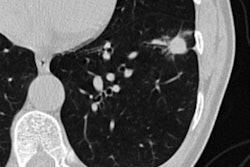
The demographic and socioeconomic factors of patients can influence whether incidental lung nodules found on chest CT are tracked appropriately, according to poster research presented at the recent RSNA 2021 meeting.
The findings point to the need to tighten follow-up protocols, noted study co-authors Dr. Eduardo Barbosa Jr. and medical student Kate Kelly, both of the University of Pennsylvania in Philadelphia.
"The likelihood of [incidental lung nodule] malignancy depends on patient and nodule factors," the two wrote. "Unless a biopsy is performed (only feasible in a small proportion of nodules), the most effective way to discern benign versus malignant is to follow over time."
But follow-up rates for incidental pulmonary nodules can be as low as 40%, even when follow-up is recommended by a radiologist. This creates many opportunities for patients to fall off the pathway to follow-up, the authors noted.
Barbosa and Kelly sought to identify the socioeconomic or demographic factors or clinical or nodule characteristics that can influence appropriate follow-up of incidental lung nodules found on chest CT. They conducted a study that included electronic medical record and U.S. Census data from 1,843 patients diagnosed with incidental pulmonary nodules on chest CT in 2016.
The researchers evaluated the follow-up of patients through 2019, tracking demographic and socioeconomic factors such as age, sex, race, employment, mean income, and education; clinical factors such as smoking history; and nodule characteristics established by the interpreting radiologist.
The main study outcomes were whether patients acted on a follow-up recommendation for an incidental pulmonary nodule and whether that follow-up was timely or delayed. Barbosa and Kelly evaluated these outcomes using chi-square univariate and multivariate logistic regression analyses.
Of the study cohort, 56.5% patients were white, 36.9% were Black, 2.9% were Asian and 3.7% were Hispanic. Most were male (62.7%), had Medicare (57.4%), and were former smokers (45.1%). The investigators also found that most of the study participants underwent chest CT in an outpatient context (60.4%).
On chi-square analysis, the team noted the following statistically significant predictors of patients never receiving follow-up for incidental lung nodules:
- Nonoutpatient settings
- Low-risk nodule
- Race other than white
- Having Medicaid or no insurance
On multivariate logistic regression analysis, the two found that patient context, nodule risk, and race were top predictors of nonadherence to incidental lung finding follow-up.
"Demographic and socioeconomic variables dominate model prediction, [with] clinical context (outpatient, inpatient, or emergency department) as the strongest predictor," they wrote. "Assessed nodule risk is also an important predictor."
The research highlights the work that needs to be done to improve adherence when it comes to tracking incidental lung findings, Barbosa and Kelly concluded.
"Our research has major implications for clinical practice, by characterizing the most vulnerable patients at risk for non-adherence to follow up of incidental pulmonary nodules, which can inform policy interventions to improve patient outcomes," they wrote in their study abstract.





















